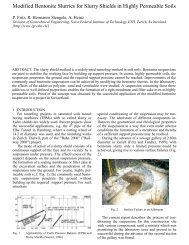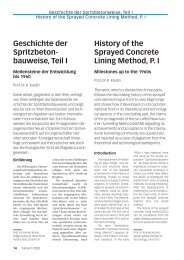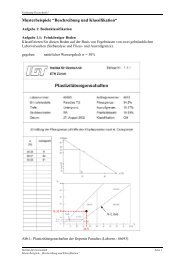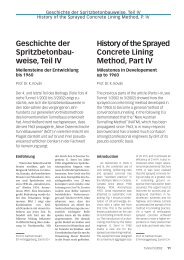Erroneous Concepts behind NATM
Erroneous Concepts behind NATM
Erroneous Concepts behind NATM
You also want an ePaper? Increase the reach of your titles
YUMPU automatically turns print PDFs into web optimized ePapers that Google loves.
ARCH ACTION<br />
GALLERY<br />
tunnelling<br />
"PROTECTIVE ZONE"<br />
Fig. 3 Arch action in cohesionsless ground Fig.4 Protective zone according to Wiesmann<br />
according to Engesser (1882, [5]) (1909/1912, [6])<br />
Wiesmann [6] described in 1912 the support function of the rock mass as follows:<br />
“If the equilibrium state within a rock mass is disturbed by excavating an underground<br />
opening then the material particles surrounding the opening have to resist that pressure<br />
as an excess pressure which before was supported by the excavated material, as<br />
is the case when we make a hole in a wall”.<br />
He further remarks that:<br />
“The tunnelling engineer does not have the task of supporting the opening for the excess<br />
rock pressure. That is done by the protective zone. He has to be concerned with<br />
the preservation of this zone”.<br />
By protective zone Wiesmann understands the rock surrounding the opening in which<br />
stress redistribution occurs, that is - in a twodimensional consideration - the plate (plane<br />
strain condition) with a hole in it (Fig. 4). The protective zone is not sharply bounded.<br />
50 years later in 1962, in the year the <strong>NATM</strong> was born, Rabcewicz [7] wrote:<br />
“I think that today in the construction of underground openings we have come to realize<br />
that the supporting material is actually the rock mass itself”.<br />
and adds:<br />
“To preserve as far as possible and to develop the support properties of the rock<br />
mass is thus the most important task of modern tunnelling”.<br />
Rabcewicz completely failed to see that this view was already well-known and taught in<br />
the textbooks of the day. Therefore, he did not apply this correct observation generally<br />
to the whole of modern tunnelling, but restricted it to the term “New Austrian Tunnelling<br />
Method” introduced by him the same year. As a result, the conceptual difficulties of the<br />
V t<br />
4






